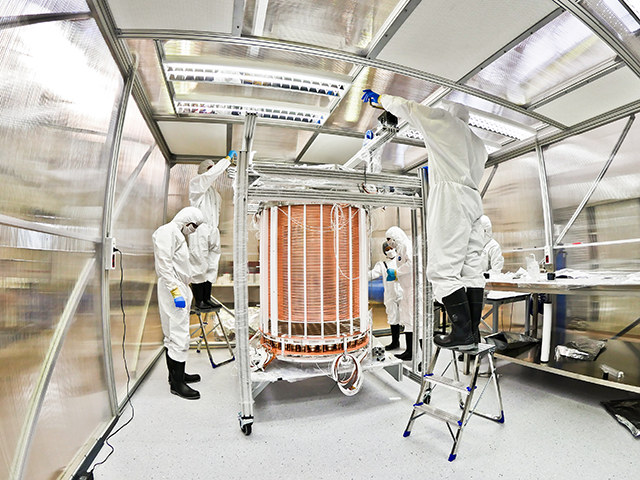The XENON1T Experiment hopes to finally detect and prove the existence of dark matter particles with the help of much, much more sensitive equipment.

Physicists suspect that dark matter, whatever it is, makes up most of the universe, including most of the Veil Nebula, seen herein thanks to the Hubble telescope. Credit: NASA, Reuters
What is dark matter? We don't know, for all that physicists think there's about five times more of it than "normal" matter, which is mostly the atoms we all know and love. Now a new international collaboration in which European, Israeli, American and Arab scientists are taking part, XENON1T, is starting in the hope of tracking down and proving the existence of the mysterious beast.
“Until now, evidence for dark matter – the matter thought to make up most of the mass in the Universe – has only been obtained indirectly, via inconsistencies in the gravitational interactions governing the dynamics of the cosmos," says Dr. Ranny Budnik, head of the Weizmann Institute team that is participating in the experiment, from the Gran Sasso Underground Laboratory in Italy.
In other words, we don't actually know that dark matter exists. But the matter that we can detect cannot explain the empiric measurements. There is something else out there. Dark matter is a theory that could explain cosmic anomalies such as why the "gravitational mass" and the "luminous mass" of galaxies and clusters of galaxies are grossly mismatched.
Physicists suspect that dark matter, whatever it is, makes up most of the universe, but consists of a sort of stable elementary particle that has escaped detection so far. The XENON1T experiment, which was inagurated on Wednesday, will be searching for this mystery matter that we can't see, at what the scientists claim is a whole new level of sensitivity.
Why have the dark particles escaped detection so far? Their interaction with ordinary matter is apparently very weak, Budnik explains. It may be too weak for humankind to have detected so far, with the technology at hand, or maybe its mass is too small. With the new experiment at the underground lab in Italy, they should be able to detect interactions far weaker than before, he postulates.
Been around 13 billion years
Why do we postulate that this dark matter is a stable particle? Because unstable ones decay, transforming into smaller particles; and the amount of dark matter in the early stages of the universe and today is the same, so it couldn't be some sort of particle that decays, Budnik explains to Haaretz. The universe is some 13 billion years old, he points out. Ergo the dark matter particle is stable, or at least lives much longer than that. (The material we're made of is also stable, by and large, Budnik adds.)

The XENON1T, which scientists hope will be able to detect dark matter particles, from its protected location 1,400 meters underground. Courtesy of the Weizmann Institute
A whole new level of sensitivity is needed for the search because existing technologies have utterly failed to detect dark matter particles – though its existence can be inferred from its gravitational effects on "normal" matter and on radiation.
Physicists estimate that about 100,000 dark matter particles pass through an area the size of a thumbnail each second, Budnik says. “The fact that we have not detected them yet tells us that the likelihood of them interacting with the atoms of our detector is very small, and that we need extremely sensitive instruments in order to find the rare signature of such a particle," he explains.
In the hope of seeing interactions of a dark matter particle, the team needed an instrument with a large mass and an extremely low radioactive background and stuck it 1,400 meters underground, to protect the array from pesky cosmic rays.
“If we are to have any chance of seeing rare interactions of a dark matter particle, we need an instrument with a large mass and an extremely low radioactive background,” says Budnik. XENON1T has photosensors so sensitive they can detect the flash of light from a single photon, as well as single electrons liberated in an interaction, he says.
The XENON Collaboration comprises 20 research groups from Germany, Italy, Switzerland, Portugal, France, the Netherlands, Sweden, Israel, the U.S., and Abu Dhabi.

Dr. Ranny Budnik is the head of the Weizmann Institute team participating in the experiment to detect dark matter. Credit: Weizmann Institute of Science
